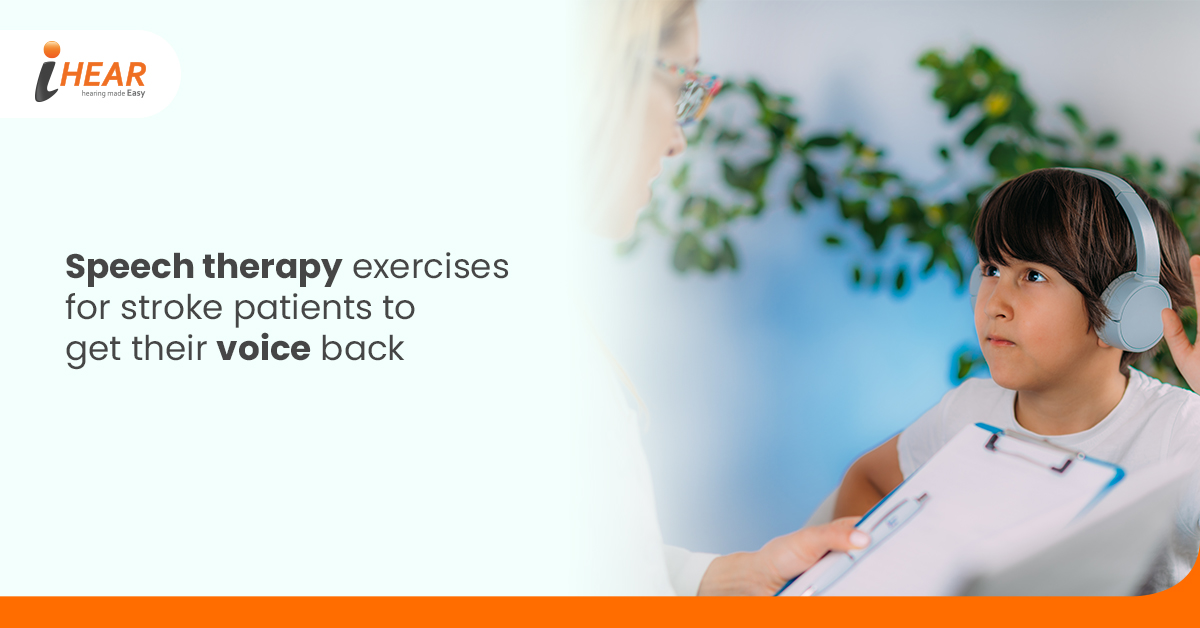Exercises for stroke patients to regain their voice through speech therapy
Most Popular Speech Therapy Exercises For Stroke Patients: A common consequence of a stroke is speech impairment. Stroke victims face a difficult time communicating with others. Even the simplest things Most patients can’t speak after a stroke. and encountered serious communication problems But the good news is that there are speech therapy exercises for stroke patients that can help during recovery.
In this blog, we will know the top speech therapy exercises which help stroke survivors regain their lost speech most effectively.
Effective speech therapy exercises for stroke patients:
At ihear.in, a distinguished speech therapy specialist showcased effective exercises tailored for stroke survivors seeking to reclaim their voices. Let’s delve into these techniques.
1. Breathing Exercises for Stroke Patients: A prevalent indication of speech impairment in stroke patients is the struggle to synchronize breathing during speech, often resulting in interruptions such as gasping or pausing mid-sentence. Engaging in breathing exercises aids in regulating and coordinating breathing patterns during conversation. Ideally, stroke patients should incorporate these exercises into their daily routine, aiming for at least two sessions per day. How a stroke patient can practice the breathing exercise:
- Inhale for 4 seconds
- Hold your breath for 4 seconds
- Exhale your breath for 4 seconds
- Hold for 4 seconds
Perform this exercise a minimum of 10 times both in the morning and evening. These breathing exercises aim to fortify your diaphragm and promote a sense of calmness. By focusing on your breath, you can develop the ability to naturally regulate both your breathing and speech.
2. Tongue In-And-Out Exercises: Your tongue plays a great role while pronouncing words. Tongue strengthening exercises like moving the tongue side by side and up and down help to strengthen the muscles and make it easier for patients to form words and converse. How to do tongue in-and-out exercise at home:
- Stick your tongue out.
- Hold it in place for 2 seconds.
- Pull it back and hold for 2 seconds.
3. Practice sentence construction: Stroke survivors often encounter difficulties in constructing coherent and complete sentences. To address this, they are encouraged to engage in exercises focusing on specific words and sounds. Additionally, reading books can enhance speech fluency and facilitate the practice of sentence construction.
4. Practice smiling regularly: Practicing smiling in front of a mirror serves as an effective method for addressing speech problems. This exercise aids in bolstering oral motor skills while also fostering encouragement to engage in further speech.
5. Make the right sound: Stroke patients face trouble saying the right sounds and words. Hence they must practice saying similar sounds, “Ah, ay, at, al, ack… etc.” While repeating the words, make sure to maintain the clarity of the sound. This exercise will strengthen the mouth and tongue to get the sounds correctly.
6. Naming Pictures: To enhance muscle coordination between visual stimuli and verbal expression, patients can engage in a practice of observing pictures and repeating associated words. Speech therapy specialists advocate for this exercise to aid in word retrieval and enhance cognitive, speech, and language functions. Patients are encouraged to repeat words multiple times to refine pronunciation and develop precise articulation with mouth and tongue muscles.
Consult a Licensed Speech Therapist for Post-Stroke Speech Recovery:
Engaging in these exercises independently on a daily basis can become monotonous without receiving feedback on progress. To ensure accuracy and motivation, consider online speech therapy for individuals coping with communication challenges post-stroke, ranging from mild to severe.
IHEAR Connects you with highly qualified speech therapists specializing in assisting stroke patients. These licensed professionals possess relevant expertise to pinpoint specific areas of concern and tailor personalized therapy plans, maximizing effectiveness in post-stroke speech recovery.

